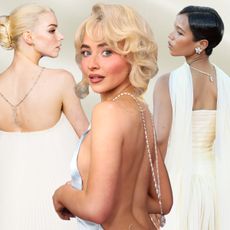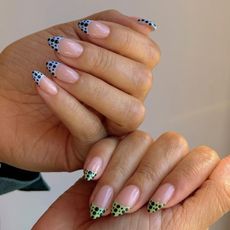The Politics of Fashion in Judas and the Black Messiah

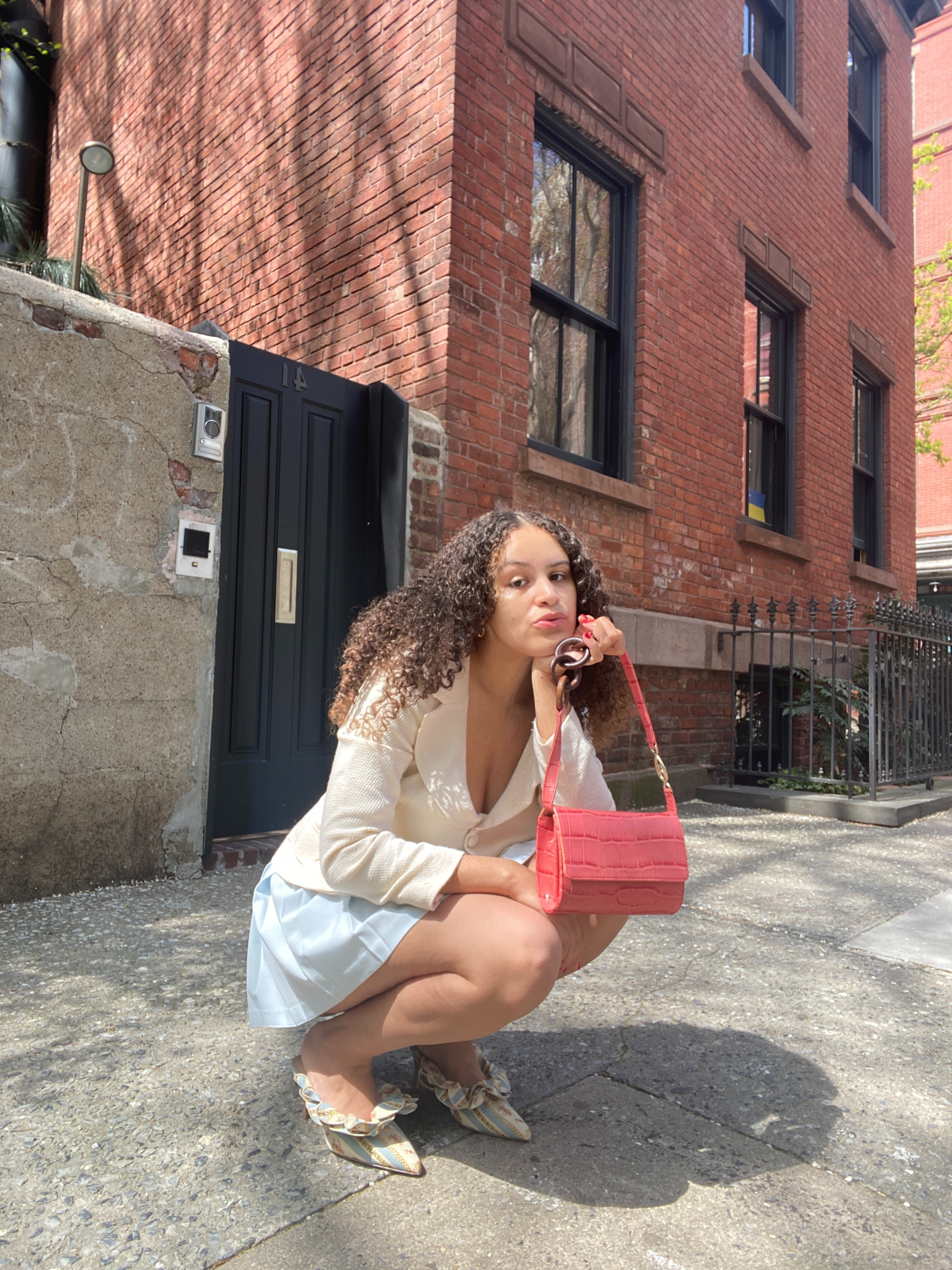
Fashion has always been fun. It’s given generation after generation the ability to relish in fun clothes and express themselves in ways unimaginable. But even the most devoted fashion lovers, myself included, are not always aware of how style is tied to cultural, political, and social movements worldwide. While it’s so much easier to pretend like a new trend doesn’t have a long history of cultural appropriation or that marginalized communities haven't long been excluded from the narrative of beauty on- and off-screen, the truth is that it’s impossible—it’s everywhere.
That truth unfolds in a captivating and bone-stirring way in the film Judas and the Black Messiah, directed by Shaka King and written by Keith and Kenneth Lucas, Will Berson, and King, which is available now on HBO Max. The narrative follows Fred Hampton (played by Daniel Kaluuya), chairman of Chicago’s Black Panther Party chapter, chronicling how the FBI targeted and eventually murdered him by blackmailing one of his fellow party members, William O’Neil (played by LaKeith Stanfield). While you may be wondering what exactly this film has to do with fashion, I’m here to tell you that, like all cultural movements, The Black Panther Party used style to convey its political beliefs. And the movement still impacts every facet of the world today, from your most beloved pop culture moments (Beyoncé’s Coachella performance) and accessories (ahem, the beret) to political policies in place today.
With that in mind, we spoke with the film’s costume designer, Charlese Antoinette Jones, to learn about what went into creating costumes for this film, the meaning behind the party’s style, and how this story is more relevant today than ever. But first, a little about Jones.
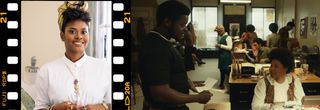
How did you get into costume design?
In 2008, I started as an unpaid intern when that was still allowed in the film industry. Interning was the only way I knew how to get into the industry because I didn’t know anyone, and I didn’t go to school for costume design, so there were no other avenues for me to get onto sets. My first internship was on Solitary Man, a Michael Douglas film. After that, I interned with Ellen Mirojnick, the costume designer who just did Netflix’s breakout show Bridgerton. After interning, I became a production assistant, and then, I joined the union as an assistant designer and assistant stylist. I was styling a lot of commercials and got the chance to work with some incredible people like Dana R. Woods (known for the film Friday) and Meredith Markworth-Pollack (known for Dynasty). I got to learn from some fantastic people early on in my career as I worked my way up.
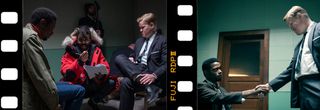
You’ve been a professional costume designer for eight years—what has been your favorite project to work on thus far, and why?
Judas and the Black Messiah is definitely one of my favorite films. But I’d be lying if I didn’t say I had three favorites: The first film I led costume design for, Newlyweeds, is very dear to my heart because I was able to encapsulate the mid-2000s era in Brooklyn and how I saw it at that time. It was a small and scrappy production, but it came out beautiful and went to Sundance. The director, Shaka King, ended up winning an Independent Spirit Award for it. It was an incredible experience for a first film, and it was my love letter to Brooklyn and my community through clothing.
See You Yesterday is also a personal favorite. It’s another movie set in New York. I loved shooting that film because I worked with many local Brooklyn designers and Black designers and customized many pieces to make the world feel authentic. The film’s subject matter was moving, telling the story of two bright kids who build a time machine to save their brother from police brutality. Spike Lee produced it, and working with him was surreal because I grew up watching his films. I feel like these two films, along with Judas and the Black Messiah, provide an interesting POV and encapsulate my best work.
Why Judas and the Messiah? What about this project interested you?
I got inspired by reading and researching about Fred Hampton’s work and what he did in the year he was the chairman of the Illinois Black Panther Party before he was murdered. Through my research, I concluded that people need to understand what the Panthers were doing during this time and that this story needs to be told accurately because people have a false, media-driven perception of the Panthers. We’ve seen the Oakland Black Panther Party chapter’s images at the state capital with guns, but people don’t understand the context. There was this focus on them being heavily militarized. Still, they weren’t breaking any laws. The Black Panthers were exercising their right to bear arms, and they were doing far more positive things for the community than the vilification of their image happening at the time in the media.
Considering the long history of how this political party has been portrayed makes this movie even more powerful. It shows how they advocated for and fed kids with their free breakfast program, raised money for medical centers, and reached out to other marginalized people. They weren’t anti–white people or any other minority group; they advocated for all poor people to come together and demand what we all deserve. They believed that our kids deserve good schools with books and resources. They believed our kids deserve food, our communities deserve medical clinics, and that there should be an end to police brutality. And all of those communities—Latino communities, white communities, and Black communities—were having those issues because they were poor. All of that attracted me to this story.
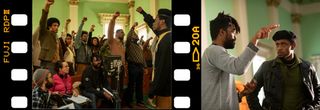
What intrigued you about creating costumes set in the early ‘70s? What was it like to bring this story to life?
This movie takes place in 1969, which is one of my favorite eras in fashion because it’s such a pivotal moment in American culture. There was so much going on from the birth of the Black Panther Party—in addition to all of the protests and counter-culture movements happening at that time—that pushed style to evolve. There’s also this futuristic fashion that’s emerging during that era because of space travel and the Apollo launch. A lot of what we understand as modern silhouettes, particularly in menswear, was established in the ‘60s. You can trace back a lot of the pieces we wear every day to the ‘60s.
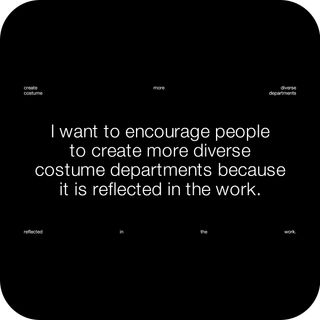
In addition to diving into the fashion of the era, it was an important project because I could also create the most diverse department I’ve ever made for a film as a department head. We had people of different ages, races, and sexual orientations and at least four different generations of contributors. That was very pivotal to shaping the looks and being able to apply lived experience to the costumes. I was proud of the team we assembled, and I think it shows in the final product, too. I want to encourage people to create more diverse costume departments because it is reflected in the work.
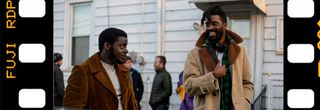
How did you create costumes for each character? What was the process?
Each character had a mood board. For the characters based on historical figures, I referenced photos from the era and used those as a starting point. From there, I took cues from these original photos to fill out their wardrobe.
How did you go about sourcing the pieces for the costumes? Were they custom? Vintage?
We had five weeks to prepare for filming. We identified vital pieces we needed to build early on, and we started working with our tailors. For example, the trench coat LaKeith Stanfield wears at the beginning of the film was custom-made. We re-created the boxers that Chairman Fred Hampton was murdered in—that was a whole process. We designed the fabric, got it printed in New York, got samples shipped back and forth, approved the samples, and then re-created those boxers in-house. Creating custom pieces was the first step in designing costumes for this film, and then, everything else that we put on people was worked out in fittings for each character. Luckily, I had an incredible team of shoppers to help purchase many vintage pieces from Los Angeles, Ohio, and Atlanta. Once we got everything to the set in Ohio, the process was sorting and organizing everything by character and fittings with our principles and background actors for filming.
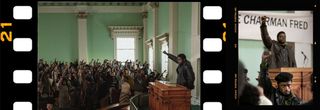
You’ve spoken about how you used historical documentation to dictate a lot of the film’s clothing choices. How did you go about researching both a party and a historical event that’s been misrepresented in mainstream media?
Do you know what’s crazy? I thought I would have a more challenging time because of exactly what you just said, but I realized there is so much out there about this if I started searching.
I watched several documentaries at that time, including this group of French documentaries that followed Fred Hampton and Bob Lee (the founder of the original Rainbow Coalition) as they met with the Young Patriots. There’s footage of Chairman Fred talking about education and having these meetings about getting the community involved. I was so surprised by how much I could find—documentaries on Amazon that were free, books from lawyers on Kindle, tons of photos on Getty Images of the Black Panther Party protests. Not to mention, I was lucky enough to have access to resources like the Western Costume Research Library and Fred Hampton Jr. himself.

Finding all this information made me wonder why I had never researched this before. I think that goes back to how we’re not taught our history; we’re not taught things, and we don’t know. Before working on set, the only thing I knew about this story was that the FBI murdered Fred Hampton because I had heard it references in music before, on T-shirts. It’s been said to me in passing in conversations about the party, but I never knew the entire history until I did the research.
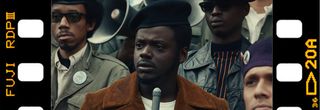
How did the Black Panther Party use style to convey its beliefs? What are the meanings behind the costumes in the film?
Most of the images we see are of the Oakland chapter, which was the Black Panther Party headquarters. These photos feature men and women in formation in powder blue button-down shirts, dark pants, dark shoes, leather jackets, sunglasses, and berets. The berets were adopted nationwide in all the chapters because they were the international symbol of revolutionaries. According to Huey P. Newton, if you were to look at movements and revolutions in third world countries around the world, the people fighting back are wearing berets, so that’s why they adopted berets into the party. And the leather jackets were worn because they were readily available. A lot of people already had them. Together, the leather jackets, sunglasses, and berets were used to conceal members’ identities for protection against the police because the police were targeting many people for being part of these types of cultural movements. That’s the intention behind the more popular uniform you’ve seen referenced in imagery.
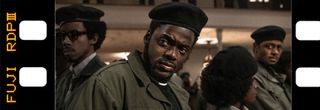
The Illinois Black Panther Party wore camo-green jackets. According to Hampton Jr., there were several reasons behind this style distinction. One is that the camo jacket was readily available. Someone served in your family, or you may have served in the Vietnam War and had just come back—just take off the U.S. Army badges and make it nondescript. It also symbolized that the U.S. government and Chicago police were at war against Black people and the Panthers specifically. Also, it highlighted the ongoing draft because there was a lot of movement against the draft and the Vietnam War, so it was also a means of protest; war was going on here, too.
From my research and conversations with Hampton Jr., it was made clear that the Black Panther Party’s uniforms were not only functional, but also they loved to flip the meaning of something and make it work for them and their causes, and that’s shown in the clothing they chose to wear. They never chose to wear this stuff to be intentionally stylish. It was functional, and it just ended up looking cool. That’s the beauty of it; their uniform made other people want to get involved in the movement because they looked so cool.
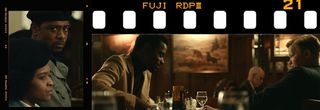
When it came to creating costumes around Kaluuya as Hampton and Stanfield as O’Neal, was your approach at all different? What did you want their outfits to convey within the film?
Because we have imagery of Fred Hampton in the world and people will watch this film precisely because they are familiar with his story, I tried my best to honor his style through Kaluuya’s costumes. I tried to re-create a lot of what he’s been photographed in and use the silhouettes of looks he’s been documented in as a basis for any other outfits he’s wearing in the film. We wanted to ground him in reality through his costumes just because he’s a well-known historical figure.
When it came to Stanfield’s wardrobe, aside from re-creating the Eyes on the Prize documentary footage and a few other images of William O’Neal, I had a lot more room to play. The director and I decided that we could take risks with his wardrobe because there wasn’t a lot to work with from a historical reference point. So from one image of O’Neal (where he’s wearing sunglasses, a polo shirt, and a handkerchief tied around his neck), I was able to access that he was a flashy dude, and I played that up as I began to create his costumes.
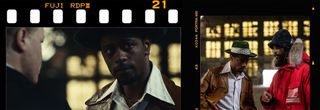
What I love about this film is that you so very clearly see O’Neal’s style evolve as he’s moving through the story—what was your intention behind that?
I had several conversations with King, the director, about how O’Neal’s style would mimic his character arc. His character goes through a journey through clothing; his clothing signals what’s happening in the story. It drives the story in a way—his character does, and his clothing does—so that was something that the director and I spoke about in great detail. When does his clothing change? How does it change? Why is he wearing a suit? Is he a fed? Is he a Panther? He’s always overdoing it, but he’s kind of lost, so we try to show that through his clothing.
From those conversations, we established that he’s dressing up as a character. When he dresses up as a "Black Panther,” he assumes that it means he would be in a leather jacket all the time because Oakland Panthers are in leather jackets all the time. But when O’Neal is not dressing as a Panther, he’s meeting agent Roy Mitchell in these incredibly flashy suits as he begins to get more money. We ended up having over 38 outfits for his character in order to reflect his character’s various identities and inner conflict.
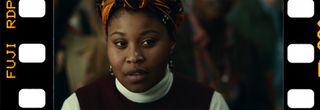
Is there one look you loved creating most within the film?
I was just discussing this with the director because I recently rewatched the color-corrected version of the film. As I was rewatching it, I was like, "Oh my god, this outfit is so ridiculous,” and it’s when O’Neal is at the phone booth, and he calls Mitchell because he’s trying to run away. He is wearing a cognac leather jacket, and his spread-collar shirt has these gold stripes on it, and he’s got these black, stripe bell-bottoms on and brown boots. Why would you wear this flashy outfit to run away? He’s so over the top. He’s just an extra person because that’s what he would choose to escape in.
That’s what made the costumes so fun to create: the ability to play with them and also honor the period. I loved all the costumes from the film, including some of the minor roles. I loved Deborah Johnson’s (played by Dominique Fishback) costumes. I wish some of her looks got a little more screen time, but I’m a costume designer, and we always wish that. There’s a lot of really awesome looks in the film. I’m thrilled with how they turned out.
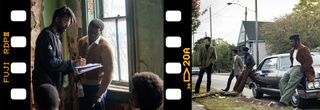
What’s incredibly powerful about this film is that the costumes transport you back to the late ‘60s, but you walk away from the film feeling like nothing has really changed. For you, how is this film more relevant than ever?
Everything that’s been happening in terms of calls for diversity and all of the protests from last summer makes this more relevant than ever. I’m a Black woman, and after reading this script and finishing the movie, I got depressed. Keep in mind this was even before all the protests about George Floyd and Breonna Taylor, but after the film wrapped, I realized not much has changed. Activists have shown up dead throughout the years. Law enforcement agencies are using the same tactics they used in the ‘60s on the Black Panther Party to protests today. The same struggles are still happening: We still have food deserts in this country, and a lot of communities don’t have access to good quality food in America. Communities don’t have access to education, which is why you see all these charter schools popping up. People are still being brutalized by the police, which is what everyone else woke up to and began to see last summer. But I’ve always been acutely aware of it as a Black woman. And so after the film, I asked myself, "What are we doing?” Nothing has changed, and I had to unpack that and work through it.
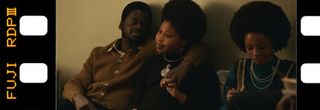
So you felt deeply depressed after your realization from creating this film. How do you move forward from that? What do you take away from this project?
What I took from it was how powerful we are as a people and the power of love. And it influenced my activism. While I was in Cleveland, I assisted the Boys & Girls Clubs of Northeast Ohio with a program called Design You. I figured, if I can provide resources to teach children how to sew in this underprivileged area, that’s going to empower them to make money in the future. I raised $1000 through family, friends, and crew members for the program. We ended up donating 10 sewing machines, supplies, and our leftover patterns and fabrics from when we wrapped the film. This center was blocks away from where we were shooting at the base camp, so Darrell Britt-Gibson (who plays Bobby Rush in the movie) organized a few fellow actors and me to speak at the club. Seeing these children, seeing how they were so interested in what we were saying, and realizing that I could make a difference made me feel less hopeless.
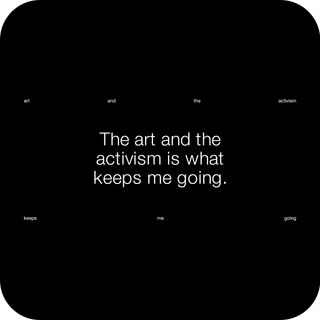
Sometimes, we think we have to tackle the larger problem, when, instead, what everyone does in pieces adds up to something big. The larger problems can be overwhelming, but if we focus on the small things we can do in our communities, they are huge. I have people reaching out to tell me about little things I did for them years ago and how it changed the trajectory of their lives. And I had no idea that small act of kindness, that job, or that money or whatever I gave to that person at that time would make such a huge difference in that way, and that’s what has kept me going in addition to making art. Art is transformative; art is healing. And art spawns conversations like this, and that’s so nourishing to me—to talk to people about my art, to tell stories through clothing, and clothing being impactful to a person’s journey. The art and the activism is what keeps me going.
Next: Meet the Hairstylists Redefining Natural Hair in Hollywood

Jasmine Fox-Suliaman is a freelance writer and editor living in New York City. What began as a pastime (blogging on Tumblr) transformed into a lifelong passion for unveiling the connection between fashion and culture on the internet and in real life. Over the last decade, she's melded her extensive edit and social background to various on-staff positions at Who What Wear, MyDomaine, and Byrdie. More recently, she’s become a freelance contributor to other publications including Vogue, Editorialist, and The Cut. Off the clock, you can find her clutching her cell phone as she's constantly scrolling through TikTok and The RealReal, in search of the next cool thing.
-
 SOS: Adam Scott and Tramell Tillman Have No Right to Look *This* Good in Jeans
SOS: Adam Scott and Tramell Tillman Have No Right to Look *This* Good in JeansTheir new outfits are criminally cool.
By Erin Fitzpatrick
-
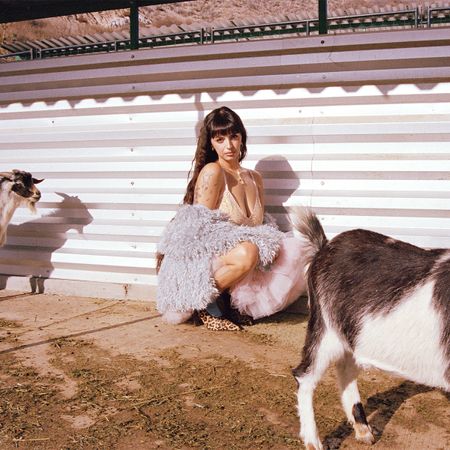 Rebecca Black Is Back and Ready to Show You All of Herself This Time
Rebecca Black Is Back and Ready to Show You All of Herself This TimeThe "Friday" singer has a brand-new pop EP, Salvation.
By Jessica Baker
-
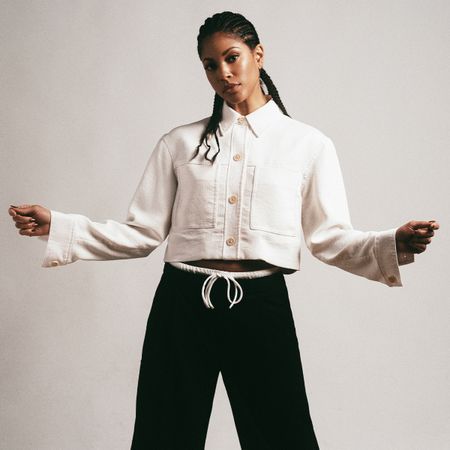 Lex Scott Davis on Joining the Suits Universe and Her Character's Iconic Wardrobe
Lex Scott Davis on Joining the Suits Universe and Her Character's Iconic WardrobeA lesson in power dressing.
By Jessica Baker
-
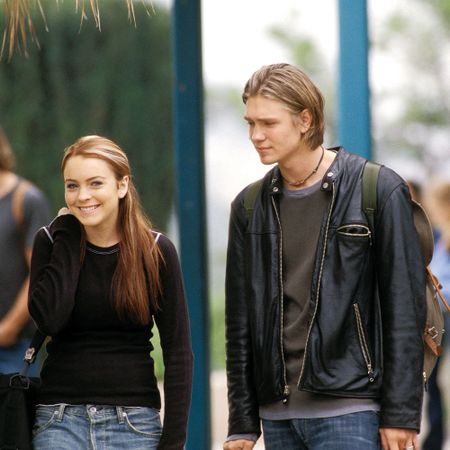 The First Trailer Just Dropped for Lindsay Lohan's Freaky Friday Sequel—Watch It Here
The First Trailer Just Dropped for Lindsay Lohan's Freaky Friday Sequel—Watch It HereThe original premiered in 2003.
By Erin Fitzpatrick
-
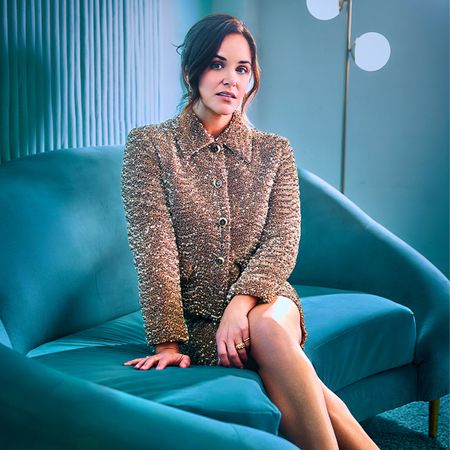 How Melissa Fumero Built One of Our New Favorite Fashion People on TV
How Melissa Fumero Built One of Our New Favorite Fashion People on TVMeet Birdie, Grosse Pointe Garden Society's queen bee and fashion person.
By Jessica Baker
-
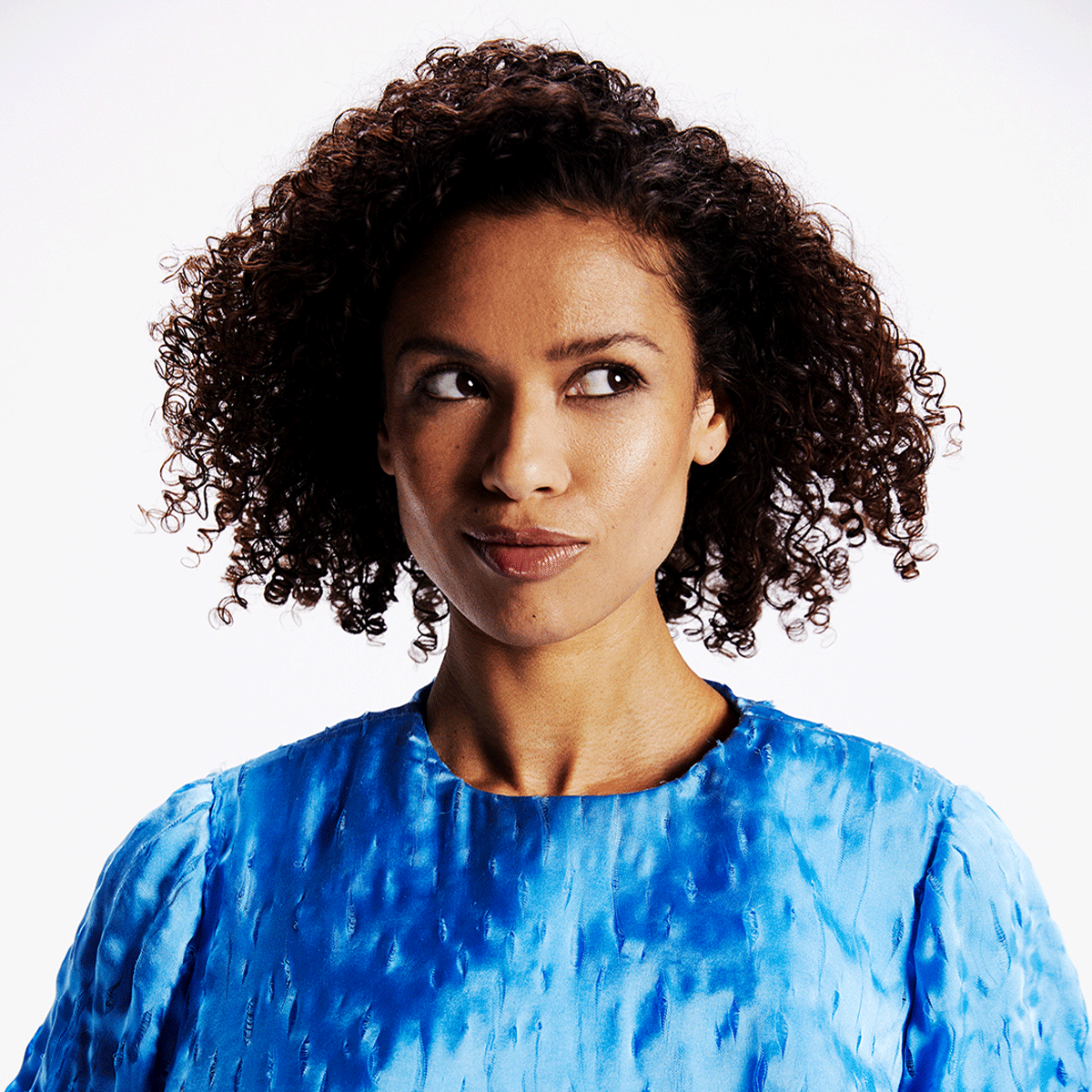 Gugu Mbatha-Raw on Surface Season 2 and the Fragrance She Uses to Get Into Character
Gugu Mbatha-Raw on Surface Season 2 and the Fragrance She Uses to Get Into CharacterHint: It's a beautiful woodsy scent full of twists and turns.
By Jessica Baker
-
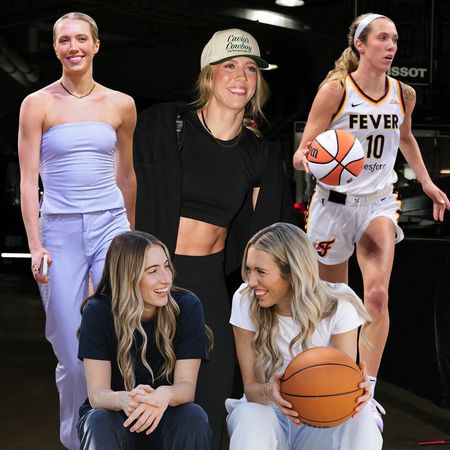 Meet Lexie Hull, TikTok's Favorite Shooting Guard Turned Influencer
Meet Lexie Hull, TikTok's Favorite Shooting Guard Turned InfluencerI spoke with Athleta's newest Power of She Collective member.
By Eliza Huber
-
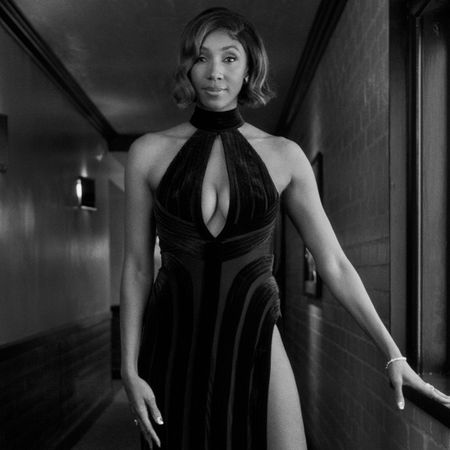 "We Knew We Had a Winner": Maria Taylor on Her Sultry Oscars Look
"We Knew We Had a Winner": Maria Taylor on Her Sultry Oscars LookWhen stylist Shiona Turini is involved, you know it's going to be good.
By Jessica Baker
